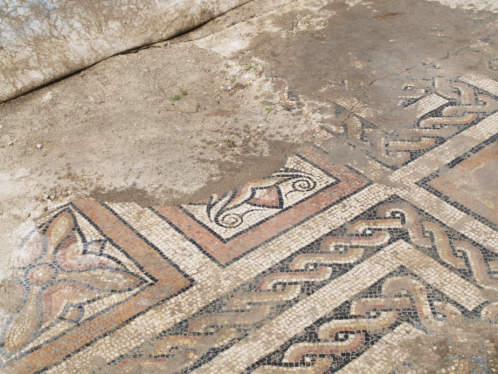Mosaic floor cleaning is slowly discovering the decorative scheme. Until now, it had been observed how the octagonal central motif is surrounded by a meandering of braided rope, intertwined, making swastikas. Also, in the southern end of the room there are four square coffered, faced two by two, and in the northern end we can see how it draws a border of lotus motifs.
 Mosaics overview with an octagonal central motif. We also can see coffered squares with floral motifs.
Mosaics overview with an octagonal central motif. We also can see coffered squares with floral motifs. Photo of the frieze of lotus-shaped motifs, located at the northern end of the room.
Photo of the frieze of lotus-shaped motifs, located at the northern end of the room.The area, which we have documented the presence of burials in sarcophagi, has been excavated in its entirety during this campaign. The results that have been documented show how all these graves have been opened and plundered several times. We observed that inside of these sarcophagi there aren’t complete burials, we only found a few unconnected bones.
 Overview of the area occupied by sarcophagi. In the left of the picture there is a carved burial site situated in an area of hydraulic concrete, the excavation of this zone is still pending.
Overview of the area occupied by sarcophagi. In the left of the picture there is a carved burial site situated in an area of hydraulic concrete, the excavation of this zone is still pending.Translated by Lara M. Moreda
Edited by Andrew B. Greeves
Edited by Andrew B. Greeves



 Central floral octagon limited by a rope motif.
Central floral octagon limited by a rope motif. Floral square caissons that are arranged in the east and west sides of the pavement.
Floral square caissons that are arranged in the east and west sides of the pavement. An image of one of the square caissons.
An image of one of the square caissons. Chapel area. We can observe different coffins, disposed therein.
Chapel area. We can observe different coffins, disposed therein. Photo of one of these burials, without exhuming.
Photo of one of these burials, without exhuming.